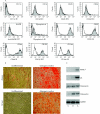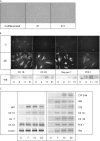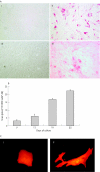Functional integration of hepatocytes derived from human mesenchymal stem cells into mouse livers
- PMID: 16928726
- PMCID: PMC1856821
- DOI: 10.1136/gut.2005.090050
Functional integration of hepatocytes derived from human mesenchymal stem cells into mouse livers
Abstract
Aims: At present, clinical success of hepatocyte transplantation as an alternative to whole liver transplantation is hampered by the limited availability of suitable donor organs for the isolation of transplantable hepatocytes. Hence, novel cell sources are required to deliver hepatocytes of adequate quality for clinical use. Mesenchymal stem cells (MSCs) from human bone marrow may have the potential to differentiate into hepatocytes in vitro and in vivo.
Methods: Isolated MSCs were selected by density gradient centrifugation and plastic adherence, differentiated in the presence of human hepatocyte growth medium and transplanted in immunodeficient Pfp/Rag2 mice.
Results: Here, we demonstrate that human MSCs gain in vitro the characteristic morphology and function of hepatocytes in response to specified growth factors. Specifically, preconditioned MSCs store glycogen, synthesise urea and feature the active hepatocyte-specific gene promoter of phosphoenolpyruvate carboxykinase (PCK1). After transplantation into livers of immunodeficient mice, preconditioned MSCs engraft predominantly in the periportal portion of the liver lobule. In situ, the cells continue to store glycogen and express PCK1, connexin32, albumin and the human hepatocyte-specific antigen HepPar1, indicating that the transplanted cells retain prominent qualities of hepatocytes after their regional integration.
Conclusion: MSCs derived from human bone marrow may serve as a novel source for the propagation of hepatocyte-like cells suitable for cell therapy in liver diseases.
Conflict of interest statement
Competing Interest: None declared.
References
Publication types
MeSH terms
Substances
LinkOut - more resources
Full Text Sources
Other Literature Sources
Medical





